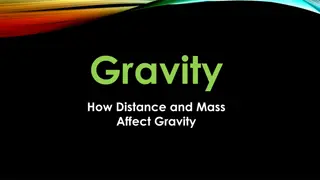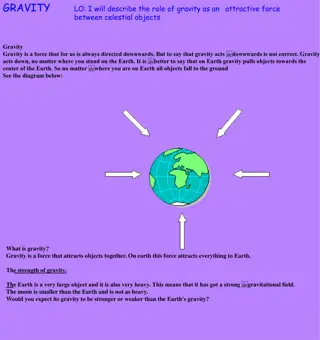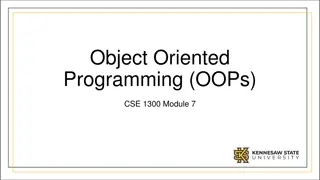PDF_⚡ Planet Earth, Past and Present: Parallels Between Our World and its Celest
\"COPY LINK HERE ; https:\/\/getpdf.readbooks.link\/3031413598\n\nget [PDF] Download Planet Earth, Past and Present: Parallels Between Our World and its Celestial Neighbors (Springer Praxis Books) | Planet Earth, Past and Present: Parallels Between Our World and its Celestial Neighbors (Springer Pra
0 views • 6 slides
Understanding Eclipses: The Celestial Dance Between the Sun, Moon, and Earth
Eclipses are fascinating astronomical events where the Moon comes between the Sun and Earth, causing either a solar eclipse or lunar eclipse. This summary delves into the different types of eclipses, such as total and partial solar eclipses, the Moon's elliptical orbit, and the intricate movements t
4 views • 25 slides
Hardware Demonstration and Improvements of the Stellar Positioning System
The Hardware Demonstration and Improvements of the Stellar Positioning System (SPS) involve utilizing ancient celestial navigation techniques for lunar exploration. SPS combines central-body-relative observation with star-field observation to determine absolute position, reducing mass/power impacts
5 views • 14 slides
Ancient Astronomy and Cosmologies Across Different Civilizations
Ancient civilizations like Babylonian, Assyrian, Egyptian, and Chinese had profound knowledge of astronomy, including tracking celestial events, developing calendars, and recording astronomical phenomena. The Greeks contributed to cosmology, contemplating the nature of the cosmos. Beliefs in a spher
2 views • 28 slides
International Legal Regulation of Space Debris and Celestial Bodies Concerns
Space debris on celestial bodies poses environmental risks and challenges in the context of economic resource exploitation. The Artemis Accords and the debate over space resource appropriation raise important legal and environmental issues that require international regulation to prevent degradation
0 views • 10 slides
Understanding Orbits and Motion in Astrophysics
Explore the concept of orbits and motion in astrophysics, covering gravitational forces, planetary orbits, orbital speeds, and celestial phenomena like lunar eclipses. Delve into how objects move in space, the relationships between orbital speed, radius, and time period, and the dynamics of celestia
0 views • 14 slides
Understanding Celestial Bodies and Constellations in the Universe
Explore the fascinating world of celestial bodies in the universe, including stars, galaxies, planets, and constellations. Learn about the formation of stars, the structure of galaxies like the Milky Way, and how constellations have been observed and named throughout history. Discover the significan
0 views • 28 slides
Understanding Newton's First Law of Inertia
Newton's first law of inertia states that objects remain at rest or in uniform motion unless acted upon by an external force. This law, also known as the law of inertia, explains how objects tend to maintain their current state of motion unless influenced by an external force. Objects at rest stay a
0 views • 14 slides
Understanding Classes and Objects in Programming
In programming, classes are fundamental building blocks that define the structure and behavior of objects. Classes contain properties, methods, and events that allow interaction between objects. Objects are instances of classes, created using the `new` keyword. Classes help organize code, encapsulat
0 views • 29 slides
Understanding Permutations in Mathematics: Concepts and Examples
Permutations are arrangements of objects in a specific order, where the number of ways objects can be arranged is calculated based on distinct objects or objects with certain restrictions. Learn about the principles of permutations, the formula to determine permutations, and how to calculate them wi
1 views • 25 slides
Understanding Orbital Mechanics: Kepler's Laws, Center of Mass, and Equation of Motion
Exploring the fundamental concepts in orbital mechanics including Kepler's Laws, center of mass calculations, and equations of motion for celestial bodies. Topics covered include the laws of planetary motion, center of mass reference frame, and the concept of reduced mass in celestial mechanics.
0 views • 15 slides
Understanding Gravity: The Impact of Distance and Mass
Objects with mass exert gravitational force, influencing each other based on mass and distance. Gravity, a fundamental force, keeps objects like Earth and the moon in orbit and affects how objects fall towards each other. The relationship between distance and gravity is crucial, affecting the streng
0 views • 12 slides
Understanding Direct and Indirect Objects in Grammar
Direct and indirect objects are essential components of sentences, helping clarify the action and recipients involved. Direct objects receive the action directly, answering the questions "Whom?" or "What?" Indirect objects indicate to whom or for whom the action is done, always appearing between the
0 views • 12 slides
Understanding Orbital Dynamics: Kepler's Laws and Newtonian Gravity
Delve into the fascinating world of orbital dynamics as we explore Kepler's Laws and Newtonian Gravity. From understanding the elliptical orbits of planets around the Sun to uncovering the role of gravity in shaping celestial motion, this journey will illuminate the fundamental principles governing
0 views • 18 slides
Poetic Reflections: Intertwined Sleep, Hawk in the Rain, Black Rook, Celestial Objects
Poetic musings intertwine dreams, nature, and inner thoughts in the works of Ted Hughes and Sylvia Plath. "In Their Entwined Sleep" delves into intimate connections, while "The Hawk in the Rain" captures a primal struggle. "Black Rook in Rainy Weather" contemplates the mundane in a rainy landscape,
0 views • 22 slides
Understanding Gravity and Center of Gravity in Physics
Gravity is the force of attraction between masses, such as Earth and objects. It gives weight to objects and has a magnitude of 32ft/s2 on Earth. The Center of Gravity (COG) is a hypothetical point where all mass appears concentrated. It plays a crucial role in determining how objects balance and mo
0 views • 13 slides
Understanding Gravity: A Fundamental Force in the Universe
Gravity is a ubiquitous force that attracts celestial objects towards each other, playing a crucial role in keeping planets in their orbits around the Sun and moons around their parent planets. This force, described by Newton's laws, is responsible for phenomena like tides and maintaining the motion
0 views • 7 slides
Understanding Gravity: The Force that Shapes Our Universe
Sir Isaac Newton's discovery of gravity revolutionized our understanding of the universe, explaining the force that keeps us grounded on Earth and governs the motion of celestial bodies. Gravity, as described by the Law of Universal Gravitation, is an attractive force that acts between all objects i
1 views • 19 slides
Understanding Gravity and Inertia: Key Concepts in Motion
Exploring the principles of inertia and gravity, this content delves into how objects resist changes in motion and the force that attracts objects towards each other. From Newton's Law of Gravity to the dynamics of free fall and weight, learn how these fundamental concepts shape our understanding of
0 views • 21 slides
Understanding Classes and Objects in Python
An exploration into the principles of object-oriented programming in Python, focusing on classes as factories for creating objects and how objects encapsulate related data and behaviors. Dive into defining classes, creating objects, and working with object methods in Python, with practical examples
0 views • 14 slides
Evocative Objects in Educational Research: A Reflective Paradigm
Delve into the role of evocative objects in educational research through a reflective practice approach, exploring generative and divergent analysis models, and considering alternative quality criteria. The creative analytic paradigm emphasizes the serendipitous nature of engaging with objects for a
0 views • 21 slides
Understanding Object-Oriented Programming (OOP) in Python
Object-Oriented Programming (OOP) is a programming paradigm that focuses on organizing code into objects with attributes and behaviors. Python supports various OOP concepts such as classes, objects, inheritance, polymorphism, abstraction, and encapsulation. Classes serve as blueprints for creating o
0 views • 29 slides
Celestial Navigation Chapter 6.1 Homework Solutions
Explore the challenges and solutions to celestial navigation through practical exercises involving star finders, celestial bodies identification, and sight planning tools. Enhance your knowledge of astronomy by setting up tools, locating planets and stars, and mastering the use of templates for plot
0 views • 22 slides
Understanding Light, Shadows, and Reflection in Science
Light is a vital form of energy that helps us see objects. Luminous objects emit light, while non-luminous objects do not. Understanding how light interacts with objects, creating shadows and reflections, is crucial in science. Transparent objects allow light to pass through, translucent objects all
0 views • 13 slides
Understanding Solar and Lunar Eclipses
Solar and lunar eclipses are celestial phenomena where shadows are cast by one celestial body upon another. A solar eclipse occurs when the Moon blocks the view of the Sun during the new moon phase, while a lunar eclipse happens when the Earth's shadow falls on the Moon. This article explains the di
0 views • 38 slides
Explore Space: Celestial Objects and Beyond
Dive into the wonders of the universe with this engaging lesson on space celestial objects. Discover the differences between comets and asteroids, explore planets and moons in our solar system, learn about stars, asteroids, comets, and galaxies, and unravel the mysteries of astronomy. Let your curio
0 views • 34 slides
Estimating Lunar Mountain Heights with Shadow Lengths
Explore how to estimate the height of lunar mountains by measuring the length of their shadows on the Moon's surface using data from the Liverpool Telescope. Discover the intriguing world of lunar shadows and how they can reveal information about celestial features. See how similar triangles and geo
0 views • 14 slides
The Moon: A Celestial Neighbor
The moon, Earth's closest celestial neighbor, orbits the Earth following Kepler's laws. With a distance of about 240,000 miles and a linear diameter of 2163 miles, the moon's mass is about 1/81 times that of Earth. Learn about the lunar orbit, nodes, and its relationship with synodic and sidereal mo
0 views • 11 slides
Global Navigation Quiz on Sights and Ho Corrections
Test your knowledge with this global navigation quiz focusing on parallax corrections for celestial bodies, GHA calculations, magnitude comparison, and more. Explore questions on lunar altitude corrections, sunrise sighting tips, and atmospheric corrections. Sharpen your celestial navigation skills
0 views • 11 slides
Understanding Verbs, Objects, and Subject Complements in Grammar
Learn about direct objects, indirect objects, and subject complements in grammar. Direct objects receive the action of the verb, while indirect objects indicate to whom or what the action is done. Subject complements follow linking verbs and describe or identify the subject. Examples and images are
0 views • 5 slides
International Laws Regulating Military Activities in Outer Space
The legal advisor, Jean-François Mayence, presented a detailed overview of international regulatory laws concerning military activities in outer space at the International Conference in Bruges, Belgium. The presentation highlighted key treaties such as the 1967 Outer Space Treaty and the 1979 Agree
0 views • 8 slides
The History of Astronomy: From Ancient Wonder to Modern Science
Astronomy, the oldest science, has fascinated humanity for millennia. From early interpretations of celestial bodies as gods to the development of instruments in Mesopotamia to predict events like eclipses, the evolution of astronomy is rich and diverse. Aristotle's theories on the cosmos laid the f
0 views • 25 slides
Analyzing Tallest Mountains in the Solar System
This document explores the tallest mountains in the Solar System and proposes theoretical models for predicting their maximum altitudes on various celestial bodies. It discusses the heights of mountains on Mercury, Earth, Moon, Mars, Vesta, Ceres, Io, and other celestial bodies, along with different
0 views • 29 slides
Concepts in Gravitational Forces and Celestial Bodies
This informative content delves into various concepts related to gravitational forces and interactions between celestial bodies like the Earth and the Moon. It covers topics such as the comparison of gravitational pulls, forces in concentric orbits, weight measurements in different scenarios, and th
0 views • 11 slides
Celestial Navigation Homework Solutions Chapter 3.1 - Taking Sights and Finding Ho, LHA, and Dec
Demonstrate and describe techniques for taking sights on moon, planets, and stars. Apply proper altitude corrections to determine Ho, compute LHA and Dec for each sextant observation, understand and apply celestial coordinates.
0 views • 16 slides
Understanding Electric Charge and Interactions Between Objects
Matter is composed of neutrons, protons, and electrons with different charges. Being charged means having an excess or shortage of charge. Grounding, insulators, conductors, and methods of charging play important roles in how objects get charged. By contacting charged objects with objects that can g
0 views • 33 slides
Global Navigation: Sunrise Sunset Quiz Chapter 2.1 Solutions
In this chapter, the solutions to various navigation problems related to sunrise, sunset, time zones, and celestial calculations are discussed. The solutions cover scenarios such as determining ZT based on given LMT and coordinates, calculating morning NT, finding ZT for morning CT, and understandin
0 views • 10 slides
Astronomy Lab Information and Schedule
In this astronomy lab course, students will explore various topics related to celestial objects, constellations, planispheres, and observational projects. The labs involve practical activities such as observing the phases of the Moon, visiting observatories, and understanding celestial coordinates.
1 views • 12 slides
Understanding the Universe: An Exploration of Celestial Bodies
Scientists study the vast expanse of the universe, birthed from the Big Bang, where stars, galaxies, and constellations exist. Exploring celestial bodies like stars, planets, and moons reveals the wonders of our universe.
0 views • 20 slides
Celestial Navigation: NASR Method Homework Solutions
Calculate altitudes, intercepts, and azimuths of celestial bodies using the NASR method. Plot celestial lines of position (LOPs) and fixes based on sights taken on the sun, moon, planets, or stars. Explore comparisons between the Law of Cosines and NASR methods for sight reduction. Practice plotting
0 views • 5 slides







































